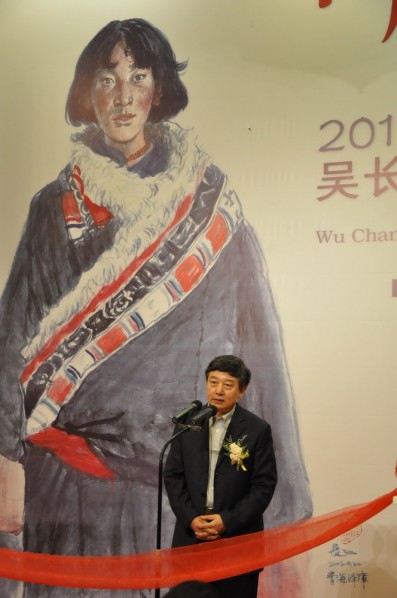
October 20, 2012, “Spirits of the Plateau: Wu Changjiang Solo Exhibition” co-sponsored by the Central Academy of Fine Arts and Shanghai Culture, Radio, Press and Publication Bureau was inaugurated at the Shanghai Art Museum. This will be the last important exhibition in the old building of Shanghai Art Museum and exhibiting dozens of prints, drawings, watercolors that Wu Changjiang has created over the years. It is not only a diachronic overview of Wu’s artistic creations, but it also comprehensively presents his recent sketching on the plateau. Nearly a hundred honored guests and media representatives from across the country have attended the opening ceremony.
Twenty famous artists and theorists participated in the “Seminar on Wu Changjiang’s Art” at the auditorium on the fourth floor of Shanghai Art Museum in the morning of October 20. It was managed by Xue Yongnian, Professor of the Central Academy of Fine Arts and Director of Chinese Artists’ Association Art Theory Committee and Shang Hui, Executive Editor of Art magazine. Fan Di’an, Chen Xiejun, Chen Lvsheng, Liang Jiang, Mao Shi’an, Hang Jian, Wu Weishan, Li Yi, Zheng Gong, Wang Hongjian, Zhu Guorong, Xu Hong, Yin Shuangxi, Ding Ning, Zhang Yuanfan, Kong Guoqiao, Lu Huan, Pan Yaochang and other experts in succession made statements to explore the creative experience, artistic features, values and contributions of Wu Changjiang.
[gallery link="file" orderby="title"]
Wu Changjiang graduated from the Central Academy of Fine Arts in 1982. From his internship at the college to teaching at the academy, he has a profound understanding of printmaking especially lithographs and drypoints. Therefore, he has dug, utilized and developed them through his integration of the temper of art languages and the Qinghai-Tibet Plateau theme. In the past 30 years, Wu has almost uninterrupted his annual visits to the plateau to experience and participate in sketching there. His solid plastic printmaking has been diversified with not only smart and elegant sketches but also heavy and unique watercolors, but what has remained the same is his sincere love of the plateau which has become his place of dreams and the inexhaustible spiritual reassurance of the house of his creations. Wu Changjiang once expressed that, “the heaven has given me an imperceptible but inexorable way, a convention with the Qinghai-Tibetan Plateau from my previous life.”
The main thread that runs through Wu’s aesthetic pursuit is the rustic and profound beauty of force embedded in the doughty plateau. Also, he forms his unique creation methods and language expressions in the process, which is kind of painting that indicates human intelligence while contributing to direct communication between the painting and audience, exhibiting human passion and exuberant vitality. Therefore, Wu does not depict the plateau through his works but interprets and comprehends it from the humanistic point of view, just as traditional printmaker Mr. Li Huanmin said, “The realistic sense of his characters is increasingly blurred while the traces of history and culture becomes more and more obvious. He seems to be looking for the ‘subsidiary material’ of national spirits from the herdsman living at the sources of three main rivers in China, which constitute the hardest core that have undergone thousands of years of sharpening.” This exhibition features dozens of works of Wu Changjiang including printmaking, drawing and watercolor. Pieces from his early periods and from his recent creations, all reflect the in-depth historical and cultural heritage and visual humanistic ideals oriented towards the eternal.
The exhibition will be in Shanghai until November 6.
Image Courtesy of Wu Changjiang and CAFA ART INFO, Photo by Hu Zhiheng/CAFA ART INFO.




























